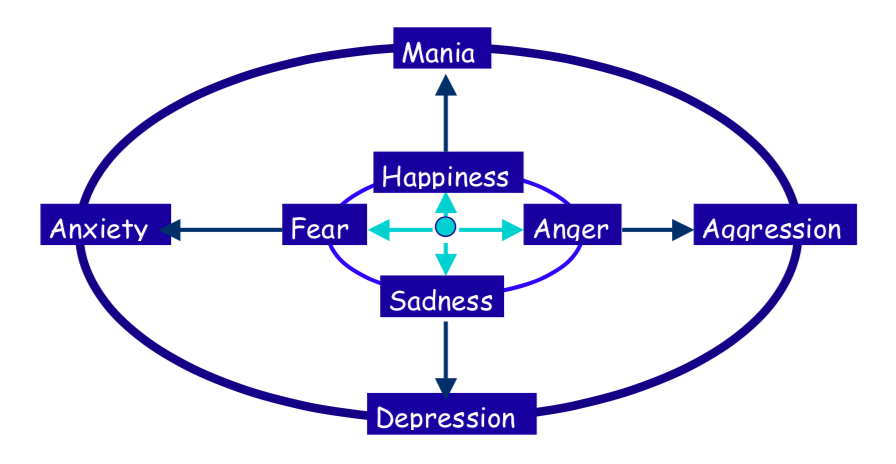Ok… lets be clear about something in our psychological world that seems to cause an awful lot of misunderstanding – there’s no such thing as a ‘negative’ emotion.
The language of ‘positive’ and ‘negative’ emotion seems to be commonplace in our popular language about mental health. This positive/negative assessment of our emotions is one which is primarily based on perceived desirability. Happiness is highly desirable, therefore we refer to it as ‘positive’. Other emotions though such as fear or sadness are not quite as desirable, and as a result are often labelled as ‘negative’.
The problem with this positive/negative or good/bad language is that it perpetuates the notion that our less desired emotions are to be avoided and that we are somehow wrong if we’re experiencing them.
An emotionally intelligent attitude sees all emotions as having value, recognising that our emotions provide us with very important information regarding our experience of the world around us. No one emotion is more valuable than another, and none of our emotions are wrong or bad.
The diagram below illustrates a model of our healthy emotional range which I developed a few years ago when I was employed to design a depression education resource for year 9 students in Victorian schools. The approach we used was one which, rather than just focussing on depression, put mental health on the agenda by first focussing on the development of healthy coping strategies to enable us to cope with all experiences within the full emotional range.

This model is what I call the ‘Four Poles of Emotions’, representing emotions as directions in which we move within the emotional range. Just like the north, south, east and west perspectives on a compass, we will be drawn in these different directions by our reactions to experiences we have in our everyday lives. None of these directions is positive or negative, nor good or bad. They are all part of the range of healthy human emotion.
Consider for a moment some of the situations in life which give rise to these emotions:
Happiness – is an emotions we are likely to experience when life is going our way, our needs are met, and we feel satisfied with our current circumstances.
Sadness – is often a reaction to disappointment or loss in our life, it’s the way we respond to life being other than how we would like it to be.
Fear – is our inner alarm system asking us to ‘be careful’ and to pay extra attention in response to a perceived threat.
Anger – can be a reaction to threat, being wronged, or a perceived injustice. Anger is our greatest motivation to change.
Of course, all of these emotions have extremes, and when we get out into the extreme range we might see a continuation from these healthy changeable emotions to their more extreme states, which could manifest as:
• Extreme Sadness – Depression
• Extreme Fear – Anxiety
• Extreme Anger – Rage
• Extreme Happiness – Mania
People can move from the healthy emotional range to developing more significant mental health issues by becoming very stuck with a particular emotion, and/or by experiencing their emotions as extreme and too difficult to cope with.
Emotional Intelligence is a psychological approach which invites us to develop more adaptive and healthy ways to cope with our emotions when they occur. This approach suggests that if we can identify our emotions and develop healthy ways of coping with them and taking care of ourselves when they occur, then the emotions themselves will pass through our lives without causing too much damage… perhaps rocking our boat a little, but leaving us anchored to a place of resilience and calm. Try working on these emotional intelligence steps:
1. Welcome all emotions fully into your awareness and get to know them – when we identify and name our emotions we are more able to respond to them appropriately
2. Ask yourself ‘how can I help myself cope with this emotion’ (as opposed to ‘how can I make it stop’)
3. Check in to see if there is a lesson you can learn from this emotion, ie. something in your life which needs to be addressed
4. Notice if there are particular emotions you tend to avoid, and consider the cost of that avoidance
5. Remember that the two psychological processes which tend to cause us the most distress are a) avoidance, and b) rigidity. So if you are doing either of these, ie. avoiding your emotions or getting stuck in a particular pattern… it might be time to seek therapy to help you address change.
THE GUEST HOUSE
This being human is a guest house.
Every morning a new arrival.
A joy, a depression, a meanness,
some momentary awareness comes
as an unexpected visitor.
Welcome and entertain them all!
Even if they are a crowd of sorrows,
who violently sweep your house
empty of its furniture,
still, treat each guest honorably.
He may be clearing you out
for some new delight.
The dark thought, the shame, the malice,
meet them at the door laughing and invite them in.
Be grateful for whatever comes.
because each has been sent
as a guide from beyond.
— Jelaluddin Rumi, translation by Coleman Barks